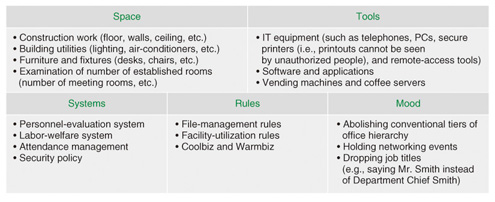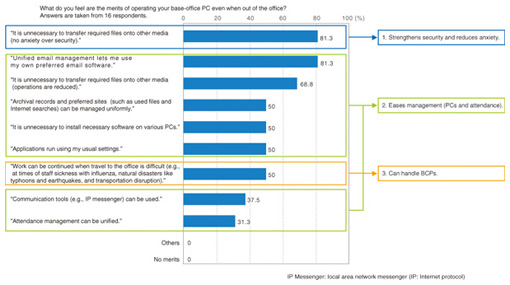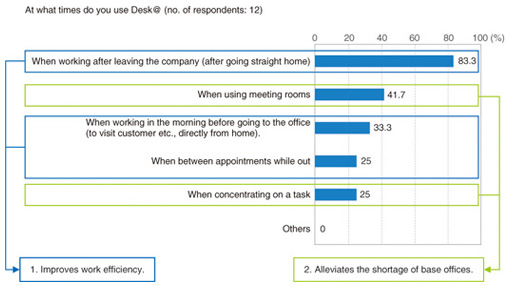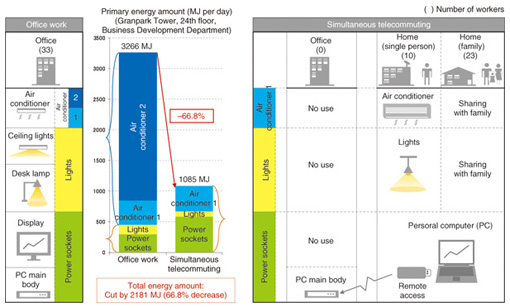 |
|||||||||||||||
|
|
|||||||||||||||
|
Feature Articles: Telework Activities Vol. 10, No. 3, pp. 28–34, Mar. 2012. https://doi.org/10.53829/ntr201203fa5 Work Style Transformation by Live-Link Design Office and TeleworkAbstractTo derive new ways of working—through telework—to the utmost extent, NTT Facilities is providing an office-building solution called Live-Link Design Office. This is intended to provide more comfortable and more efficient offices than those that have been available up until now.
1. IntroductionNTT Facilities is providing a facility-integration service for integrating three core technologies: information technology (IT), energy technology, and architectural technology. This service brings four key benefits to customers: it maximizes property value, minimizes facility costs, improves intellectual productivity, and responds to concerns about the global environment and safety and security. This article introduces a transformation in work style through telework and office design to suit that transformation, which will make it even easier to pass on these benefits to customers. Customers who expect improvements in intellectual productivity through office transformation strongly desire not only the provision of offices as space for simple work but also the creation of an indoor environment that should improve the intellectual productivity of company workers while assuring a comfortable and healthy environment. However, the relationship between indoor environmental performance and intellectual productivity is influenced by various factors; accordingly, there are various viewpoints concerning what kind of analysis axes to use for quantitative evaluation. Applying our past achievements and experience gained to date [1], NTT Facilities has developed a work-style diagnosis system*1 that features quantitative evaluation of intellectual performance on two axes: 1) Live for individual motivation and 2) Link for team communication (Fig. 1).
The questions are all in the form of: "Do you agree or disagree with the following statements? 1) The environment enables necessary information to be obtained easily. 2) It lets workers concentrate on their work. 3) It is comfortable and easy to use. 4) It is one that you would choose to work in. 5) It enables workers to choose where to work. 6) It makes you feel secure mentally and physically. 7) It enables workers to communicate with each other frankly. 8) It lets workers easily feel refreshed. 9) It enables workers to create and cooperate together. 10) It is an environment that workers are proud of. Quantification of an office environment lets one compare data before and after an office has been transformed and objectively evaluate the office design (a process that has tended to be done by gut feeling until now). Moreover, by implementing the work-style diagnosis system and promoting office design utilizing the system, it becomes possible to visualize the problems afflicting an office environment and to prepare efficient and effective office-design plans. In this manner, providing office consulting and office design in an integrated fashion is the key feature of Live-Link Design Office [2] (Fig. 2), an office-design software program developed and used by NTT Facilities.
2. Basic design of an office by Live-Link Design OfficeTo remedy the problems afflicting an office environment visualized by the work-style diagnosis, Live-Link Design Office*2 drafts office-reformation plans that will change peoples’ ways of working. It separates the functions of an office into seven scenes, which are locations (spaces) where job functions are performed (Fig. 3). According to the way in which scenes are connected and allocated, it is possible to create spaces in which individual motivation is improved and communication is enriched. As an example of scene connection, a space accommodating computer printers and servers (scene name: academy) and a space where workers refresh themselves (scene name: break) could be placed adjacent to each other so that conversation between someone taking a short break and someone waiting for a printout becomes natural and spontaneous. The transformation of office-space allocation in a model office constructed at NTT Facilities in 2010 is shown in Fig. 4.
In the pre-transformation layout, exclusive spaces for individuals (scene name: station) take up most (78%) of the office space; on the other hand, in the post-transformation (new) layout, the figure was suppressed to 45%, and there is more shared space (lack of which was a major complaint). Despite the fact that no changes were made to the physical location of the office, floor area, and tenants, the implementation of work-style diagnosis had two main effects: the Live-Link value after transformation was dramatically improved and intellectual productivity was raised to an extremely high level. After the way of connecting and allocating scenes has been determined, to maximize the functional capability of the seven scenes, five schemes are incorporated into the scenes (Fig. 5). For example, some of the schemes related to break (the scene in which workers can refresh themselves) facilitate a relaxing effect by using natural colors for carpets (responding to the concern about the type of space), installing vending machines dispensing snacks (providing good tools), establishing a personnel-evaluation system that places emphasis on planning proposals thought up by stimulating informal communication and on original ideas resulting from the aforementioned refreshing effect (creating suitable systems), abolishing reservation systems so that everybody can use tables easily (improving rules), and holding monthly networking events across departments (improving mood).
3. Telework and ubiquitous officesTo embody a customer’s management philosophy and corporate culture in an office, it is important to investigate office design on a conceptual basis. Recently, there has been an increase in the number of customers actively promoting a balance between work and free time (work-life balance) while trying to make work more efficient. For such customers, we are proposing the ubiquitous office—namely, a work environment that allows a worker to flexibly choose where and when to work. As an office (anywhere inside or outside the company) that can create an environment providing the same working performance as the base office, the ubiquitous office is created by adopting a way of working that puts telework to maximum use, for example, supporting working from home, introducing thin-client systems into the company, and creating a remote-access environment (which can be accessed from personal computers (PCs) carried out and about and from rental offices in membership-system Internet cafes). At NTT Facilities, a ubiquitous office was set up, and a ubiquitous-office trial was performed to assess its effectiveness and gain experience (accumulate know-how). The effect of implementing the trial ubiquitous office (for the year 2010) was determined. In particular, the cost benefit of working outside the office (using the ubiquitous office) was calculated from the unit cost for labor. This calculation showed that the cost of travelling time was reduced by about 10,000 yen per business trip; travelling was made more efficient by about 20,000 yen per trip; and travelling expenses were cut by 500 yen per trip. On top of these cost benefits, other benefits—such as reduced anxiety over security (by eliminating the need to carry data), unification of PC data, and correspondence with business continuity plans (BCPs) covering times of difficulty in getting to work—were mentioned by trial participants as merits of the ubiquitous office (Fig. 6). In addition, the results of analyzing the purposes for which a rented office (called Desk@) was used (usage scenes) not only showed the effects of making work more efficient (including use while out of the office), but also confirmed the effect of alleviating the shortage of base offices (such as using Desk@ as a meeting room or place for work requiring concentration) (Fig. 7).
4. Telework and eco-officesIn recent years, businesses have been focusing their attention on environmental measures in the office; however, in response to power shortages resulting from the Great East Japan Earthquake (March 2011), they are once again focusing their attention on the importance of energy-saving measures. At NTT Facilities as well, we have been actively developing technologies and services for saving energy. The essential ingredients concerning these energy-saving efforts are thoroughness of energy management and establishment of an eco-work style by transforming our way of working. Eco-work style, defined as a style of working that is ecologically or environmentally friendly, is achieved through actively promoting telework and trying to make work more efficient through measures such as Japan’s Coolbiz and Warmbiz campaigns [3], paperless meetings, videoconferences, universal layouts, working from home, and mobile work. 5. Energy-saving effect of teleworking en masseImplementing working from home (as one form of telework) en masse was calculated to be very effective in terms of energy savings in an office building. The calculated effect of such an implementation, assuming that one department (33 people) occupying the NTT Facilities head office (in Tokyo’s Minato ward) implements teleworking in unison on one day in summer, is plotted in Fig. 8. If none of the staff of one department come to the office, it is possible to not turn on the air-conditioning, lighting, and some power sockets (for printers, vending machines, etc.) for an occupied space of 300 m2. Although the workers use lights and air-conditioners in their homes and communication devices (including PCs) for accessing PCs in the base office, which are still turned on, the implementation would achieve a 66.8% decrease in the amount of primary energy [4] used. Moreover, implementing mass teleworking on a regular basis in this manner also helps BCPs by acting as practice for continuing business during times of crisis.
6. Future developmentsFrom now on, to diversify specific support services for solving problems concerning offices through work-style diagnosis, we will continue actively implementing IT services (like telework) in offices. Moreover, by verifying the precise effect of this implementation while giving even more thought to office environments, we will continue to expand our integrated facility services which combine IT, energy, and architectual technologies by, for example, developing automatic control programs for building utilities and ensuring the consistency of IT-based visualization of energy savings. References
|
|||||||||||||||
















